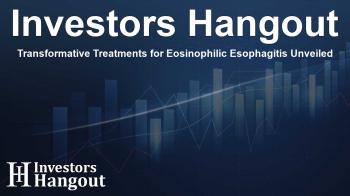Transformative Treatments for Eosinophilic Esophagitis Unveiled

Revolutionizing Eosinophilic Esophagitis Management
The dynamics of the eosinophilic esophagitis market are expected to witness significant transformation in the near future. Innovative therapies such as APT-1011 from Ellodi Pharmaceuticals, tezepelumab from AstraZeneca, and ESO-101 by EsoCap are on the cusp of launching, promising to enhance treatment options for patients suffering from this complex condition.
Understanding Eosinophilic Esophagitis
Eosinophilic esophagitis (EoE) is a chronic, multifaceted disease characterized by varying clinical manifestations. These manifestations can include differences in the age of onset, specific symptoms, progression of the disease, and responses to treatment. Despite challenges in diagnosis and management, existing clinical studies indicate that the primary cause of EoE relates to an allergic inflammatory reaction driven by CD4+ T helper type 2 (Th2) cells reacting to food allergens within the esophageal lining. The prevalence of EoE is rising, with estimates showing about 800,000 diagnosed cases within the broader population.
Current Treatment Options
The current therapeutic approaches to eosinophilic esophagitis encompass dietary changes, medical interventions, and, when necessary, endoscopic procedures. Among the pharmacological options, proton pump inhibitors (PPIs) and corticosteroids are prevalent but come with challenges, including a propensity for relapse. Currently, there are only a handful of approved medications for EoE, including DUPIXENT (dupilumab) and JORVEZA (budesonide).
DUPIXENT: A Key Medication
DUPIXENT, a human IgG4 monoclonal antibody, works by inhibiting the signaling of IL-4 and IL-13 proteins. This medication received FDA approval for EoE treatment in mid-2022 for adults and adolescents aged 12 years and older. Its indications have since expanded to include children as young as one year. The drug was developed with Regeneron's innovative VelocImmune technology and has been co-developed with Sanofi, showcasing its significant impact on treating EoE.
JORVEZA: Another Viable Option
Developed by Dr. Falk Pharma GmbH, JORVEZA is a non-halogenated glucocorticoid effective in reducing inflammation by activating glucocorticoid receptors. It was approved in early 2018 and holds orphan drug designation, providing crucial support for adults suffering from EoE.
Emerging Therapies Ready to Launch
As the landscape of eosinophilic esophagitis treatment continues to evolve, emerging therapies promise to expand options for patients. Medications like tezepelumab, APT-1011, and ESO-101 could bring new hope to those affected by EoE. Tezepelumab, a monoclonal antibody, targets thymic stromal lymphopoietin (TSLP), which is instrumental in initiating inflammatory responses. APT-1011 represents an innovative approach, employing an oral formulation designed for targeted delivery to the esophagus. It has received multiple designations intended to fast-track its approval based on promising clinical data.
The Future of the Eosinophilic Esophagitis Market
The eosinophilic esophagitis market is projected to expand widely in the coming years, with estimates suggesting a growth from approximately USD 1.8 billion. This growth will be driven by increased awareness of the disease and a rise in healthcare spending, presenting lucrative opportunities for pharmaceutical companies to deepen their market penetration.
Market Insights and Future Directions
DelveInsight's recent market report sheds light on various crucial facets regarding the eosinophilic esophagitis landscape. The report highlights epidemiological forecasts, analyses of treatment norms, and a comprehensive view of patient demographics affected by EoE.
Frequently Asked Questions
What causes eosinophilic esophagitis?
Eosinophilic esophagitis is primarily triggered by an allergic reaction to specific food allergens, resulting in inflammation of the esophagus.
How is eosinophilic esophagitis diagnosed?
Diagnosis typically involves a combination of medical history review, endoscopic examination, and biopsy of the esophageal lining to check for eosinophils.
What are the most common symptoms of eosinophilic esophagitis?
Common symptoms include difficulty swallowing, chest pain, heartburn, and food impaction.
Are there effective treatments for eosinophilic esophagitis?
Current treatments include dietary modifications and medications like DUPIXENT and JORVEZA, with emerging therapies on the horizon.
What is the outlook for the eosinophilic esophagitis market?
The market is expected to grow significantly due to rising awareness and the introduction of innovative therapies, potentially reaching USD 1.8 billion in the coming years.
About The Author
Contact Logan Wright privately here. Or send an email with ATTN: Logan Wright as the subject to contact@investorshangout.com.
About Investors Hangout
Investors Hangout is a leading online stock forum for financial discussion and learning, offering a wide range of free tools and resources. It draws in traders of all levels, who exchange market knowledge, investigate trading tactics, and keep an eye on industry developments in real time. Featuring financial articles, stock message boards, quotes, charts, company profiles, and live news updates. Through cooperative learning and a wealth of informational resources, it helps users from novices creating their first portfolios to experts honing their techniques. Join Investors Hangout today: https://investorshangout.com/
The content of this article is based on factual, publicly available information and does not represent legal, financial, or investment advice. Investors Hangout does not offer financial advice, and the author is not a licensed financial advisor. Consult a qualified advisor before making any financial or investment decisions based on this article. This article should not be considered advice to purchase, sell, or hold any securities or other investments. If any of the material provided here is inaccurate, please contact us for corrections.

